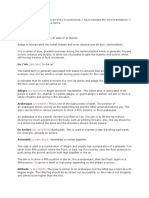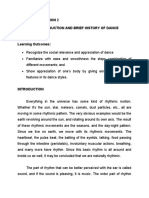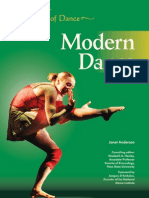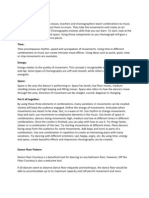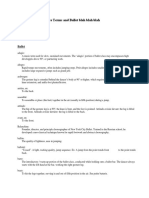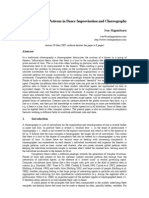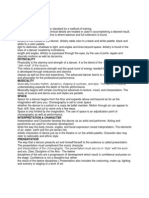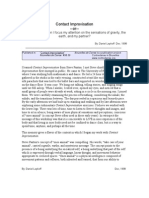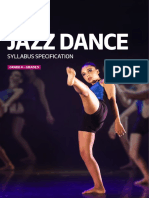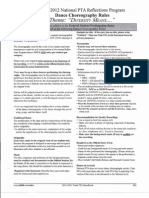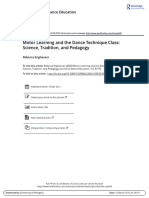The Five Principles of Choreography
The Five Principles of Choreography
Uploaded by
kenheldCopyright:
Available Formats
The Five Principles of Choreography
The Five Principles of Choreography
Uploaded by
kenheldCopyright
Available Formats
Share this document
Read this document in other languages
Did you find this document useful?
Is this content inappropriate?
Copyright:
Available Formats
The Five Principles of Choreography
The Five Principles of Choreography
Uploaded by
kenheldCopyright:
Available Formats
The Five principles of choreography
All choreography (regardless of genre) is based on the following five principles.
• Dynamics
• Space
• Relationships
• Actions
• Body Parts
Each part is like a jigsaw piece and which join to create an effective dance.
It may help to think if them like a five pointed star as shown below.
Use this star to help you to analyse professional choreography and to create
choreography of your own.
Actions
Which actions are used?
Jump Fall Balance
Travel Turn Gesture
Stillness Contact Dynamics
Arabesque Attitude How it moves?
Space
Plié Pirouette Time - Fast/Slow
Where in space?
Port de bras Lift Weight - Strong/Gentle
3 levels Pathways
Promenade Catch Space - Direct/Indirect
Personal General
Counterbalance Adage Flow - Bound/free
Upstage Downstage
Counter tension Jeté Tempo – rhythm
Stage right Stage left
Centre stager
Words which describe
the qualities of the
actions.
Relationship
What are the relationships? Body Part/Body Shape
Near or far from other dancers Which body part is used?
Near of far from audience Head Neck Face
Solo Duet Trio Group Eyes Back Chest
Narrative Thematic Abstract Stomach Arms
Canon/Unison Hands Feet Legs
With/without/on/in beside a set Fingers Toes Hips
With/without music Curved Free Straight
Type of music
In time or dancing through the Angled Wide Tall
music Twisted
Costume, lighting, props
Reversed Repeated Reduced
Reordered
Binary Ternary Rondo
You might also like
- Appreciating Dance: A Guide to the World's Liveliest ArtFrom EverandAppreciating Dance: A Guide to the World's Liveliest ArtNo ratings yet
- Laban Lesson PlanDocument4 pagesLaban Lesson Planapi-348256739100% (1)
- Buckwalter Melinda - Composing While Dancing, An Improviser's CompanionDocument245 pagesBuckwalter Melinda - Composing While Dancing, An Improviser's CompanionManuel CoitoNo ratings yet
- Jazzdance PDFDocument39 pagesJazzdance PDFkavya_architecture100% (4)
- Ballet DictionaryDocument11 pagesBallet DictionaryAnonymous Maam4RNo ratings yet
- Lesson 1 - Introduction and Brief History of DanceDocument8 pagesLesson 1 - Introduction and Brief History of DanceSoojuu sojuu100% (4)
- Gaynor MindenDocument29 pagesGaynor MindenStephanieAliciaSalim100% (1)
- How Does Dance Influences MusicDocument25 pagesHow Does Dance Influences MusicAnonymous Ppy44KNo ratings yet
- Organizational Principles in Dance ChoreographyDocument23 pagesOrganizational Principles in Dance ChoreographyJay R BayaniNo ratings yet
- Fundamentals of Dance HandbookDocument55 pagesFundamentals of Dance Handbookmikijister100% (1)
- 4D in Contermporary DanceDocument219 pages4D in Contermporary DanceTTTalianaNo ratings yet
- Laban's Eight EffortsDocument2 pagesLaban's Eight EffortsCamille Hildebrandt100% (2)
- Ballet SyllabusDocument18 pagesBallet SyllabusKaley Jensen100% (1)
- Moder Dance Book - 2nd EditionDocument119 pagesModer Dance Book - 2nd EditionLinoraD2182% (11)
- Dancing Deeper Still: The Practice of Contact Improvisation: The Practice of Contact ImprovisationFrom EverandDancing Deeper Still: The Practice of Contact Improvisation: The Practice of Contact ImprovisationRating: 3 out of 5 stars3/5 (1)
- A VERY Brief Overview of Dance HistoryDocument2 pagesA VERY Brief Overview of Dance HistoryAngelito Halmain100% (1)
- Dance LessonDocument2 pagesDance Lessonapi-294876413No ratings yet
- Fields in Motion: Ethnography in the Worlds of DanceFrom EverandFields in Motion: Ethnography in the Worlds of DanceNo ratings yet
- CrowdSurf General GuidelinesDocument26 pagesCrowdSurf General GuidelinesJuan Sanchez100% (1)
- Dance Composition BasicsDocument105 pagesDance Composition BasicsSharie Faith Binas100% (1)
- Dance - The Elements of DanceDocument2 pagesDance - The Elements of DanceKaila SalemNo ratings yet
- Elements of ChoreographyDocument4 pagesElements of ChoreographyMichelleCurvaNo ratings yet
- The Art of ChoreographyDocument22 pagesThe Art of ChoreographyRosa Meneses100% (2)
- History of Modern Dance Student HandoutDocument13 pagesHistory of Modern Dance Student HandoutKim Joshua A. GudezNo ratings yet
- Principles of ChoreographyDocument1 pagePrinciples of ChoreographyOhiwei OsawemenNo ratings yet
- Dance Terms and Ballet Blah Blah BlahDocument11 pagesDance Terms and Ballet Blah Blah BlahColton CarrigoNo ratings yet
- Ohad NaharinDocument15 pagesOhad NaharinmartinaNo ratings yet
- Curriculum Guide DanceDocument12 pagesCurriculum Guide Dancepirhotmunthe100% (4)
- Emergent Patterns in Dance Improvisation and ChoreographyDocument9 pagesEmergent Patterns in Dance Improvisation and ChoreographyFecioru Tatiana100% (1)
- Dance Choreography RulesDocument1 pageDance Choreography Rulesapi-377964292No ratings yet
- Elements of DanceDocument4 pagesElements of DancePRINTDESK by DanNo ratings yet
- Dance ChoreographyDocument5 pagesDance ChoreographyjapeengNo ratings yet
- Contact Improvisation - What Happens WhenDocument3 pagesContact Improvisation - What Happens WhenRenata SavoNo ratings yet
- On Laban Movement AnalysisDocument5 pagesOn Laban Movement AnalysisJoshuaNo ratings yet
- Pedagogical Practices in Dance EducationDocument25 pagesPedagogical Practices in Dance EducationTina ZubovicNo ratings yet
- Thomas DeFrantz 2018 Black DanceDocument13 pagesThomas DeFrantz 2018 Black DanceRomain BigéNo ratings yet
- KPOP DanceDocument1 pageKPOP DanceJairo TanyagNo ratings yet
- Dance and Improvisation PHD Thesis PDFDocument320 pagesDance and Improvisation PHD Thesis PDFAnonymous CjcDVK54No ratings yet
- Dramaturgies of TH Gaga Bodies - Kinesthesia and HealingDocument23 pagesDramaturgies of TH Gaga Bodies - Kinesthesia and HealingDinis ZanottoNo ratings yet
- Contemporary Dance 1Document25 pagesContemporary Dance 1Merra Mae S. ArmadaNo ratings yet
- Elements of Performing ArtsDocument13 pagesElements of Performing ArtsJustine LissetteNo ratings yet
- Blueprint For Teaching and Learning in Dance, PreK-12Document169 pagesBlueprint For Teaching and Learning in Dance, PreK-12RaulLuisConicica100% (2)
- Hip Hop DanceDocument20 pagesHip Hop Dancepinals90No ratings yet
- The Significance of Space: Dance AestheticsDocument22 pagesThe Significance of Space: Dance AestheticsKim LamNo ratings yet
- Teaching Methods Ballet 1 ClassDocument10 pagesTeaching Methods Ballet 1 ClassNicoleMakenaBrowneNo ratings yet
- Contemporary DanceDocument7 pagesContemporary Dancesamm yuuNo ratings yet
- Expanded Choreographies – Choreographic Histories: Trans-Historical Perspectives Beyond Dance and Human Bodies in MotionFrom EverandExpanded Choreographies – Choreographic Histories: Trans-Historical Perspectives Beyond Dance and Human Bodies in MotionNo ratings yet
- PAA Jazz Dance Syllabus Grade4 Grade5Document55 pagesPAA Jazz Dance Syllabus Grade4 Grade5June Bayta100% (3)
- Michael Klein, ChoreographyDocument233 pagesMichael Klein, ChoreographyKatarzyna Słoboda100% (2)
- What Is Laban MovementDocument1 pageWhat Is Laban MovementFranz Muriel Gutierrez100% (1)
- LMA-Workshop-Sheet LABAN PDFDocument6 pagesLMA-Workshop-Sheet LABAN PDFsabinalazarNo ratings yet
- Elements of DanceDocument4 pagesElements of DanceCloyd VillegasNo ratings yet
- Contemporary DanceDocument3 pagesContemporary DanceJesuv Cristian CleteNo ratings yet
- Key Differences Between Modern and Contemporary DanceDocument3 pagesKey Differences Between Modern and Contemporary DanceMaryAnnAnabe100% (1)
- DANCE DISCOURSE AND SCRIPTS FOR THE STAGE. Volume 1Document88 pagesDANCE DISCOURSE AND SCRIPTS FOR THE STAGE. Volume 1Association of Dance Scholars and Practitioners of Nigeria100% (1)
- YognycDocument20 pagesYognycManohar Kakade100% (2)
- Dance Choreography RulesDocument1 pageDance Choreography RulesTori Stoddard ThorneNo ratings yet
- Motor Learning and The Dance Technique Class Science Tradition and PedagogyDocument10 pagesMotor Learning and The Dance Technique Class Science Tradition and PedagogyDoDongBulawinNo ratings yet
- What Is Modern DanceDocument12 pagesWhat Is Modern DanceAmril E-Man Radzman0% (1)
- Structured Breathing - Fitzmaurice (VASTA)Document4 pagesStructured Breathing - Fitzmaurice (VASTA)germany23No ratings yet
- Lecture One/ Paragraph Writing General PDFDocument20 pagesLecture One/ Paragraph Writing General PDFOmnia Elkholy67% (3)
- Sheldon Pollock and The Sanskrit Knowledge PDFDocument11 pagesSheldon Pollock and The Sanskrit Knowledge PDFAshutoshNo ratings yet
- Act of Settlement 1700 PDFDocument6 pagesAct of Settlement 1700 PDFAnonymous 5dtQnfKeTq0% (1)
- Character ListDocument7 pagesCharacter ListJediOsaíBenitezNo ratings yet
- Language Literacy and Listening Comprehension QuestionnaireDocument4 pagesLanguage Literacy and Listening Comprehension QuestionnaireJelo AnievasNo ratings yet
- How To Use PowtoonDocument132 pagesHow To Use PowtoonvatwistNo ratings yet
- Traditional Folk MediaDocument7 pagesTraditional Folk MediaEliazyra Venice KerrNo ratings yet
- The Dilemma Short Story-Vijay Dan DethaDocument12 pagesThe Dilemma Short Story-Vijay Dan DethaNeha Sharma100% (3)
- 076 What About Yin and YangDocument3 pages076 What About Yin and YangmcdozerNo ratings yet
- 06-1 Assemblies ComponentsDocument4 pages06-1 Assemblies ComponentschinnavenkateswarluNo ratings yet
- Kathiravan MusicDocument6 pagesKathiravan MusicMohammed Noufal ThundiyilNo ratings yet
- QUARTER 3 Loop-A-Word-Instrumental-Music-of-the-Romantic-Period PDFDocument2 pagesQUARTER 3 Loop-A-Word-Instrumental-Music-of-the-Romantic-Period PDFRauven Jean Erodias FadriquelaNo ratings yet
- Wizard of Oz Allegory Character ListDocument1 pageWizard of Oz Allegory Character ListTyler Roberson0% (1)
- False CeilingDocument23 pagesFalse CeilingZhwan Anwar100% (1)
- Document C: Lord Louis Mountbatten (Modified) : VocabularyDocument2 pagesDocument C: Lord Louis Mountbatten (Modified) : VocabularyRaNo ratings yet
- OT DOCUMENT BestDocument67 pagesOT DOCUMENT BestChido Shamhu100% (1)
- Write Up - Origin of Pashto Language and Phases of Its Literary DevelopmentDocument8 pagesWrite Up - Origin of Pashto Language and Phases of Its Literary DevelopmentAsadullah Gandapur0% (1)
- TopDocument35 pagesTopChirag kumarNo ratings yet
- TAT 6.45finalDocument29 pagesTAT 6.45finalDolly SinghNo ratings yet
- Better Photo TipsDocument16 pagesBetter Photo Tipsmaxfun365No ratings yet
- "O People! "Indeed Ahead of You Is The Blessed Month of AllahDocument8 pages"O People! "Indeed Ahead of You Is The Blessed Month of AllahLhrAnnouncementNo ratings yet
- Vincent D'indyDocument23 pagesVincent D'indyPaul Franklin Huanca AparicioNo ratings yet
- Ad EngDocument192 pagesAd EngJoniithanSc2No ratings yet
- Archicad Template Checklist v2 0Document7 pagesArchicad Template Checklist v2 0nedblaNo ratings yet
- Usage - Woodoc-25-Polyurethane-Floor-Sealer-SatinDocument1 pageUsage - Woodoc-25-Polyurethane-Floor-Sealer-SatinNc BeanNo ratings yet
- Wenyanwen Part-Two 1.0Document123 pagesWenyanwen Part-Two 1.0Joel KlevjeNo ratings yet
- FAQ On Printing at ComCen UTown PDFDocument3 pagesFAQ On Printing at ComCen UTown PDFrevo17No ratings yet
- Goals & Evolution of Human Computer InteractionDocument9 pagesGoals & Evolution of Human Computer InteractionhhumasNo ratings yet
- The Theme of PartitionDocument5 pagesThe Theme of PartitionFitness Bro100% (1)




